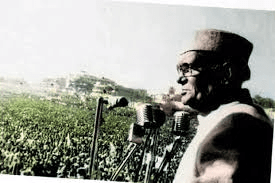According to the original schedule, the second general elections in the history of Pakistan, and the first after the dismemberment of the country, were to be held in the second half of 1977. However, on January 7, 1977, Bhutto announced that the elections would be held earlier. On January 10, Justice Sajjad Ahmad Jan, Chief Election Commissioner, announced the election schedule and declared January 19 and 22 as the last date for receipt of nominations for National Assembly and Provincial Assemblies, respectively. To many, the idea was not to give sufficient time to the opposition in order to make decisions and arrangements for the forthcoming elections. Election symbols were allocated to all the political parties. The total registered voters in the country were 30,899,052. Two hundred and fifty five Returning Officers were appointed for the National Assembly elections by the Election Commission.
Immediately after the announcement, Bhutto started his election campaign. The first step he took was the allocation of tickets to his party men. Unlike the 1970 elections, when Pakistan Peoples Party mainly banked on socialistic slogans, this time Bhutto also relied on political heavyweights. A number of feudal lords and other influential persons were allocated party tickets. Bhutto himself held public meetings all over the country, and to get further support from the common man, he announced labor reforms on January 4, and a second set of land reforms on January 5. The attendance in the public meetings was amazing in all parts of the country, especially in interior Sindh and Punjab. The opposition blamed Bhutto for using Government machinery in running his election campaign.
The biggest problem for Bhutto and his Pakistan Peoples Party was that nine important parties of the opposition had joined hands and formed an alliance, named as Pakistan National Alliance. P. N. A. decided to contest the elections under one election symbol “plough” and a green flag with nine stars as its ensign. Throughout their election campaign, instead of giving their own agenda, P. N. A. leadership mainly concentrated on echoing the alleged misdeeds of Bhutto’s Government, corruption, mismanagement of national wealth, heavy expenditures on administration and disastrous economic policies evidenced by inflation. The P. N. A. leaders also exploited the deteriorating law and order situation and misuse of law enforcing agencies against the political opponents. They claimed that the fundamental rights had been curtailed during Bhutto’s era.
P. N. A. managed to exploit anti-Bhutto sentiments among a huge section of masses and thus their election campaign received an unexpectedly positive response. Their claim, that their manifesto was Quran, also helped them in winning over a sizable number of voters from all over Pakistan. The attendance in P. N. A. public meetings and rallies was at times unexpected, even for the Alliance leadership itself.
Finally the elections were held on March 7 in which Pakistan Peoples Party managed to win 155 out of 200 seats in the National Assembly. The results of the elections astonished political pundits both inside and outside Pakistan. Pakistan National Alliance was only able to win 36 National Assembly seats. To add insult to injury, the Alliance could only win 8 out of 116 seats of the National Assembly from Punjab, and failed to win even a single seat from Lahore and Rawalpindi, cities in which they had organized big public gatherings and processions.
Pakistan National Alliance leaders protested that there had been a systematic rigging of election results to defeat them. At many places, particularly where the P. N. A. candidates were strong, the polling was alleged to have been blocked for hours. There were also reports that P. P. P. armed personnel in police uniform removed ballot boxes. Marked ballot papers were also found on the streets in Karachi and Lahore. Rumors quickly circulated that the results in key constituencies were issued directly from the Prime Minister’s office. P. N. A. boycotted the provincial elections. P. P. P. resorted to bogus voting merely to prove that voters had come to cast their ballot. Overall P. P. P. gained 99 percent seats. The voting figures showing the success of the P. P. P. candidates often surpassed the actual number that turned up for voting.
At last Martial Law was imposed by Zia-ul-Haq who appointed a committee to inquire into the alleged rigging of the National Assembly polls. This committee was reported to have found a blueprint of the plan of rigging from the Prime Minister House. The inquiry committee alleged that Bhutto had prepared this plan as early as April 1976, under the title of “A Model Election Plan”, later known as the “Larkana Plan”. In an interview to Associated Press of Pakistan, Sajjad Ahmad Jan, the Chief Election Commissioner admitted that the failure of the electoral process was by and large due to the candidates of the ruling party, who exploited their position and party machinery and thus destroyed the sanctity of the ballot box.
This article was last updated on Sunday, June 01, 2003






